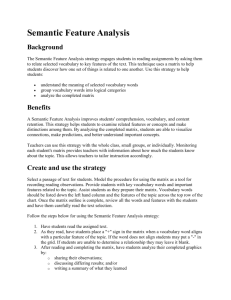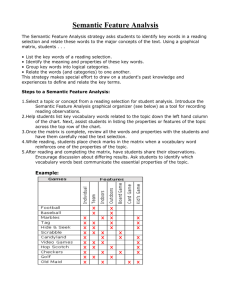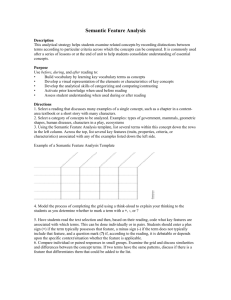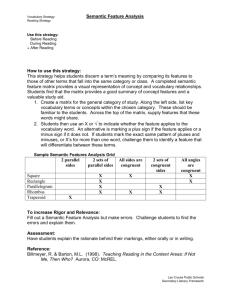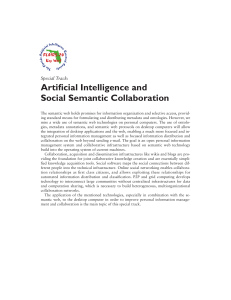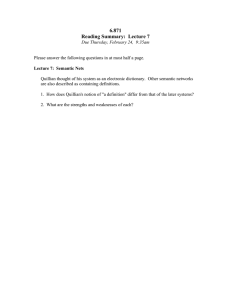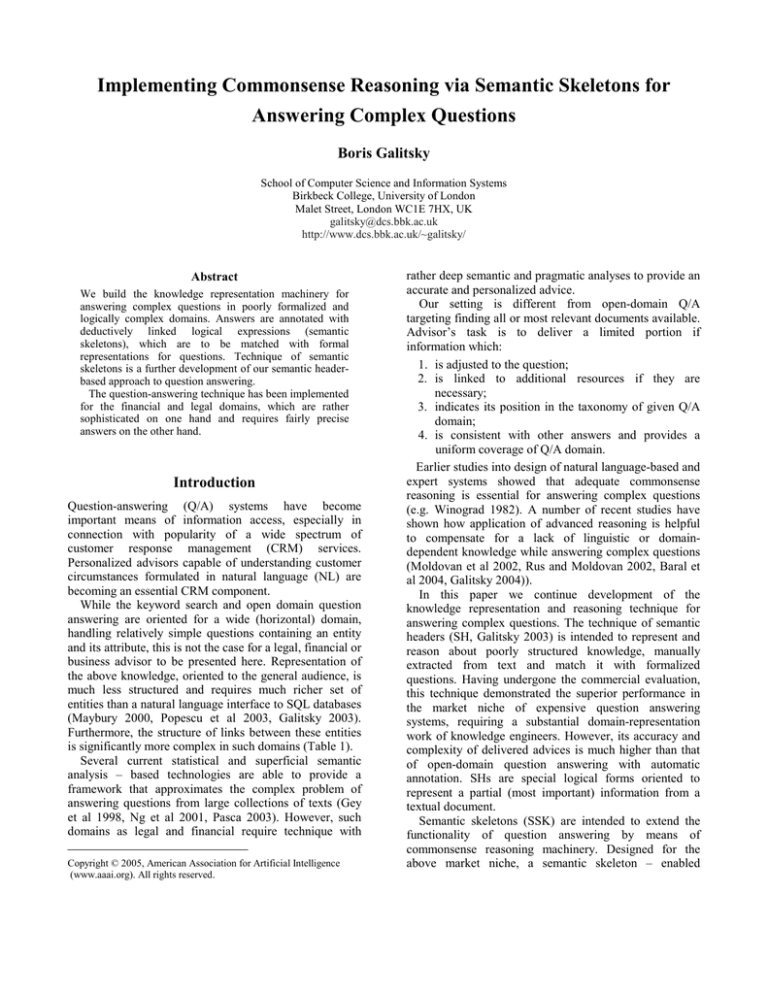
Implementing Commonsense Reasoning via Semantic Skeletons for
Answering Complex Questions
Boris Galitsky
School of Computer Science and Information Systems
Birkbeck College, University of London
Malet Street, London WC1E 7HX, UK
galitsky@dcs.bbk.ac.uk
http://www.dcs.bbk.ac.uk/~galitsky/
Abstract
We build the knowledge representation machinery for
answering complex questions in poorly formalized and
logically complex domains. Answers are annotated with
deductively linked logical expressions (semantic
skeletons), which are to be matched with formal
representations for questions. Technique of semantic
skeletons is a further development of our semantic headerbased approach to question answering.
The question-answering technique has been implemented
for the financial and legal domains, which are rather
sophisticated on one hand and requires fairly precise
answers on the other hand.
Introduction
Question-answering (Q/A) systems have become
important means of information access, especially in
connection with popularity of a wide spectrum of
customer response management (CRM) services.
Personalized advisors capable of understanding customer
circumstances formulated in natural language (NL) are
becoming an essential CRM component.
While the keyword search and open domain question
answering are oriented for a wide (horizontal) domain,
handling relatively simple questions containing an entity
and its attribute, this is not the case for a legal, financial or
business advisor to be presented here. Representation of
the above knowledge, oriented to the general audience, is
much less structured and requires much richer set of
entities than a natural language interface to SQL databases
(Maybury 2000, Popescu et al 2003, Galitsky 2003).
Furthermore, the structure of links between these entities
is significantly more complex in such domains (Table 1).
Several current statistical and superficial semantic
analysis – based technologies are able to provide a
framework that approximates the complex problem of
answering questions from large collections of texts (Gey
et al 1998, Ng et al 2001, Pasca 2003). However, such
domains as legal and financial require technique with
Copyright © 2005, American Association for Artificial Intelligence
(www.aaai.org). All rights reserved.
rather deep semantic and pragmatic analyses to provide an
accurate and personalized advice.
Our setting is different from open-domain Q/A
targeting finding all or most relevant documents available.
Advisor’s task is to deliver a limited portion if
information which:
1. is adjusted to the question;
2. is linked to additional resources if they are
necessary;
3. indicates its position in the taxonomy of given Q/A
domain;
4. is consistent with other answers and provides a
uniform coverage of Q/A domain.
Earlier studies into design of natural language-based and
expert systems showed that adequate commonsense
reasoning is essential for answering complex questions
(e.g. Winograd 1982). A number of recent studies have
shown how application of advanced reasoning is helpful
to compensate for a lack of linguistic or domaindependent knowledge while answering complex questions
(Moldovan et al 2002, Rus and Moldovan 2002, Baral et
al 2004, Galitsky 2004)).
In this paper we continue development of the
knowledge representation and reasoning technique for
answering complex questions. The technique of semantic
headers (SH, Galitsky 2003) is intended to represent and
reason about poorly structured knowledge, manually
extracted from text and match it with formalized
questions. Having undergone the commercial evaluation,
this technique demonstrated the superior performance in
the market niche of expensive question answering
systems, requiring a substantial domain-representation
work of knowledge engineers. However, its accuracy and
complexity of delivered advices is much higher than that
of open-domain question answering with automatic
annotation. SHs are special logical forms oriented to
represent a partial (most important) information from a
textual document.
Semantic skeletons (SSK) are intended to extend the
functionality of question answering by means of
commonsense reasoning machinery. Designed for the
above market niche, a semantic skeleton – enabled
knowledge domain provides a better coverage of a totality
of possible questions. This is due to the fact that an
“emergent” question is expected to be deductively linked
to one or more of the existing annotated answers by
application of commonsense reasoning, inherent to SSK.
How much lower is an adjustable rate mortgage compared
to a fixed rate loan?
Does the "start" rate quoted by lenders on a loan stay in
effect for the term of the mortgage?
How can I avoid negative amortization on an adjustable
rate mortgage?
How risky is a 125 percent loan to value second
mortgage?
Table 1: The samples question of mortgage domain. NLP
system needs to handle up to four entities to perform Q/A in
financial domains. Neither keyword search – based nor
statistical nor syntactic match can provide satisfactory advising
in vertical domains.
To conclude the introduction, we outline the desired
suite of features we are attempting to achieve by SSK –
based knowledge representation machinery:
1) simplicity and expressive power;
2) capability to reason with incomplete information;
3) existence of a well developed programming
methodology;
4) availability of rather efficient reasoning features;
5) encoding defeasible relations, defaults, causal
relations,
argumentations,
and
inheritance
hierarchies;
6) being elaboration-tolerant knowledge base, i.e., be
able to accommodate new knowledge without doing
large-scale modification.
Semantic headers of answers
The problem of question answering in a vertical domain is
posed as building a mapping between formal
representations of the fixed set of answers and formal
representations of possible questions. The technique of
semantic headers is intended to be the means of
conversion of an abstract textual document into a form,
appropriate to be associated to a question and to generate
an advice (Galitsky 2003). There are two opposite
common approaches to this problem. The first one
assumes that complete formal representation of any
textual document is possible, and the second one assumes
that the textual information is too tightly linked to the NL
and it cannot be satisfactorily represented without it. The
former approach relies on the match of formalized query
with the full knowledge representation for answers, and
the latter is based on syntactic match between the question
and the sentences from answers.
The semantic header (SH) technique is an intermediate
one in respect to the degree of knowledge formalization. It
is intended to be the means by which an abstract textual
document is converted into a form appropriate to be
associated to a question and to generate an answer
(Galitsky 2003). Only the data, which can be explicitly
mentioned in a potential query, occurs in semantic
headers. The rest of the information, which would be
unlikely to occur in a question, but can potentially form
the relevant answer, does not have to be formalized.
SH technique is based on logic programming, taking
advantage of its convenient handling of semantic rules on
the one hand, and its explicit implementation of a
domain’s common-sense reasoning on the other hand. The
declarative nature of coding semantic rules, domain
knowledge and generalized potential queries introduces
suggests logic programming as a reasonable tool (Baral
et.al. 2004).
Let us consider the Internet Auction domain, which
includes the description of bidding rules and various types
of auctions.
“Restricted-Access Auctions. This separate category
makes it easy for you to find or avoid adult-only
merchandise. To view and bid on adult-only items, buyers
need to have a credit card on file with eBay. Sellers must
also have credit card verification. Items listed in the
Adult-Only category are not included in the New Items “
What is this paragraph about? It introduces the
“Restricted-Access” auction as a specific class of
auctions, explains how to search for or avoid selected
category of products, presents the credit card rules and
describes the relations between this class of auctions and
the highlighted sections of the Internet auction site. We do
not change the paragraph in order to adjust it to the
potential questions answered within it; instead, we
consider all the possible questions this paragraph can
serve as an answer to:
What is the restricted-access auction? This question is
raised when a customer knows the name of the specific
class of auction and wants to get more details about it.
What kind of auctions sells adult-only items? How to
avoid adult-rated products for my son? Do you sell adult
items? These are the similar questions, but the class of
auctions is specified implicitly, via the key attribute adultonly.
When does a buyer need a credit card on file? Why does a
seller need credit card verification? These are more
specific questions about what kind of auctions requires
having credit cards on file, and what is the difference in
credit card processing for the auction seller/buyer. The
paragraph above serves as answer to these questions as
well, and since we are not dividing the paragraph into
smaller fragments, the question addressee will get more
information than he/she has directly requested; however
this additional information is relevant to that request.
Below is the list of semantic headers for the answer above.
auction(restricted_access):-restrictedAuction.
product(adult):-restrictedAuction.
seller(credit_card(verification,_),_):-restrictedAuction.
credit_card(verification,_)):-restrictedAuction.
sell(credit_card(reject(_,_),_),_):-restrictedAuction.
bidder(credit_card(_,_),_):-restrictedAuction.
seller(credit_card(_,_),_):-restrictedAuction.
what_is(auction(restricted_access,_),_):restrictedAuction.
Then the call to restrictedAuction will add the paragraph
above to the current answer, which may consists of
multiple pre-prepared ones.
Now we will briefly introduce a generic set of
semantic headers, taking advantage of the technique of
non-conventional logic programming. For an entity e, its
attributes c1, c2, …, variables over these attributes C, C1,
as well as other involved entities e1,…, and the ID of
resultant answer, SHs look like the following:
e(A):-var(A), answer(id). This is a very general answer,
introducing (defining) the entity e. It is not always
appropriate to provide a general answer (e.g. to answer
What is tax?>), so the system may ask a user to be more
specific:
e(A):-var(A), clarify([c1, c2, …]). If the attribute of e is
unknown, a clarification procedure is initiated,
suggesting the choice of an attribute from the list c1,
c2,… to have a specific answer about e(ci) instead of just
for e(_).
e(A):-nonvar(A), A = c1 , answer(id). The attribute is
determined and the system outputs the answer associated
with the entity and its attribute.
e(e1(A)):-nonvar(A), A= c1 , e1(A).
e(e1(A),e2):-nonvar(A), A≠ c1 , e2(_). Depending on the
existence and values of attributes, an embedded
expression is reduced to its innermost entity that calls
another SH.
e(A,id). This (dead-end) semantic header serves as a
constraint for the representation of a complex query,
e1(A,id), e2(B,id), to deliver just an answer(id) instead of
all pairs for e1 and e2 . It works in the situation where
neither e1 nor e2 can be substituted (into each other).
Note that var/1 and nonvar/1 are the built-in
PROLOG metapredicates that obtain the respective
status of variables.
From the perspective of logic, the choice of semantic
header to be matched against a formal representation of a
query corresponds to the search for a proof of this
representation, considering SHs as axioms.
We conclude this Section by the following definition.
Semantic headers of an answer are the formal
generalized representations of potential questions.
Semantic headers contain the essential information of
answers and serve to separate them, being matched with
formal representations of questions. Semantic headers
are built taking into account:
• The set of other semantically close answers.
• The totality of relevant questions, semantically
similar to generic questions above.
Semantic skeletons
Evidently, a set of SH represents the associated answer
with the loss of information. What kind of information
can be saved given the formal language that supports
semantic headers?
When we extract the answer identifying information
and construct the semantic headers we intentionally lose
the commonsense links between the entities and objects
used. This happens for the sole purpose of building the
most robust and compact expressions for matching with
the query representations. Nevertheless, it seems
reasonable to conserve the answer information which is
not directly connected with potential questions, but useful
for completeness of knowledge being queried. A semantic
skeleton (SSK) can be considered as a combination of
semantic headers with mutual explanations of how they
are related to each other from the answers perspective.
SSKs are domain-specific and coded manually by
knowledge engineers
SSKs serve the purpose of handling the queries not
directly related to the informational content of the
answers, represented by semantic headers. For an answer
and a set of semantic headers, an SSK derives an
additional set of virtual headers to cover those questions
which require a deductive step to be linked with this
answer. In other words, a semantic skeleton extends a set
of questions which is covered by existing semantic
headers towards the superset of questions, deductively
connected with the former ones. It happens during a
question answering session, unlike the creation of regular
SHs which are built in the course of domain construction.
Yielding virtual SHs in a domain can be written as ∀a
SSK : {SH(a)} → {vSH(a)}, where {SH(a)} is the set of
original semantic headers for answer a, and {vSH(a)} is
the set of virtual semantic headers derived from SSK for
an answer a. A virtual semantic header (vSH) can be
yielded by multiple answers (Galitsky 2003). However, a
vSH cannot be a regular header for another answer (note
that two semantic headers for different answers are
allowed to be deductively linked): ∀a,a’ vSH(a) ∩
SH(a’)=∅. Hence, a vSH for a query is an expression
that enters a clause of the semantic skeleton and can be
matched with the translation formula of a query or its
conjunctive component. In the latter case, the terms of
mentioned clauses must not match with the negations of
the (conjunctive) components of that translation formula.
The idea of SSK is depicted in Figure 2. The input
query is matched against the vSHs if there is no
appropriate regular semantic header to match with. Virtual
semantic headers are obtained given the terms of SSK
clauses. The SHs are assigned to answers directly.
However, vSHs are assigned to answers via clauses. Both
Answer1 and Answer2 may have other assigned regular
and virtual SHs.
In p u t q u e s tio n
F o r m a liz e d q u e r y
S e m a n t ic
h ead er
A n sw er 1
M a tc h
N o m a tc h
H ead
:-
B o d y1
C la u s e o f s e m a n tic s k e le t o n
V ir t u a l
s e m a n tic
h ead er
B o d y2
B o d y3
A n sw er 2
Fig. 1: Illustration for the idea of semantic skeletons
For example, imagine a semantic header tax(income)
that is intended to handle questions about tax brackets in
the Tax domain: how the tax amount depends on income.
Evidently, this answer would be a relevant one to the
question What would my tax be if I lost my job last year?
Since losing a job is not directly related to tax (the former
is deductively linked to the latter via income, job(lost)→
not income(_)), it would be unreasonable to have a special
semantic header to link tax and job-lost. Therefore, the
expression job(lost) serves as a virtual semantic header in
the TAX domain, being generated dynamically from the
clause job(lost)→ not income(_), instead of being a
regular one. If we do not use the regular semantic header
instead of the virtual one for the entities which are neither
deductively nor syntactically linked in a query, it would
damage the domain structure and lead to an excess
number of semantic headers. Indeed, this used to happen
before the concept of the SSK was introduced.
At the same time, in the IRA domain the loosing job
scenario is under special consideration, and expressions
ira(tax(income)) and ira(job(lost)) are expected to be the
semantic headers for different answers; one for
calculating tax on IRA distribution amount that depends
on income, and the other for the special case of tax on
IRA distribution under employment termination. Thus a
pair (triple, etc.) of entities may form a vSH (that
requires a SSK-clause that would yield, generally
speaking, multiple links between entities) or, form a
regular header, depending on whether these entities are
directly semantically or syntactically linked in a query.
The clauses of the semantic skeleton are not directly
used to separate answers, so they can be built as
complete as possible irrespectively on the knowledge
correlation with other answers. Furthermore, semantic
skeletons for a pair of answers may overlap, having the
common clauses.
As well as approximation of meaning by SHs, SSKs
are capable of involving approximate semantic links. For
example, various forms of payment questions are
addressed to the Internet retailer domain which usually
has an answer about credit card payment. How should we
handle the questions mentioning payment by check, money
order, wiring etc? “Pure” SH technique requires
enumeration of SHs:
payment(check):-credit_card_payment_answer.
payment(money_order) :-credit_card_payment_answer.
payment(wiring) :-credit_card_payment_answer.
payment(credit_card) :-credit_card_payment_answer.
However, using a SSK clause: payment(X):-member(X, [
check, money_order, wiring, credit_card ]),
one can use the fourth SH above as a regular SH and the
first three ones as virtual SHs, involving the clause about
forms of payment. The advantages of using a SSK are the
lower number of SHs to code, clearer semantic structure
of a domain and reusability of encoded commonsense
knowledge for the similar domains.
We proceed to another example of a semantic
skeleton. Again, the semantic headers need to be
deductively linked via the clauses, involving the entities
from these semantic headers and other ones. The clauses
below present the explanation of how a term divorce is
linked to the terms marriage, tax, file, separate, and joint.
The first clause, completing the set of semantic headers
above, introduces the commonsense fact that being
divorced is an opposite entity to being married. The
second clause is saying that if a couple was filing a joint
tax return before the divorce, they are filing separate tax
returns afterwards. Enumeration of terms within a clause
may be used to express the temporal relationship of a
sequence in time (read file(joint) then divorce(_)).
divorce(_):- not marriage(_).
tax(file(separate)):- file(joint), divorce(_).
single(_):-divorce(_);not marriage(_).
Using just the semantic headers we can answer the
divorce questions without knowing that divorce ends
marriage! Surprisingly, one does not need to know that
fact to separate answers about divorce. Intuitively, a
speaker would definitely need some basic commonsense
facts to talk about a topic, but an agent can answer
questions about a topic, including rather specific and
deep questions, without these facts. SSKs come into
play, in particular, to semantically link the basic domain
entities. At the same time, a semantic skeleton is the least
knowledge required to have all the entities linked.
Note that the predicates we use to describe the tax
issues of marriage to occur in an SH for Q/A are
different from ones we would use to better formalize the
domain itself. The SH-oriented predicate divorce ranges
over its attributes, which are reduced to a single
argument, and an extended predicate divorce in a logic
program would have two arguments ranging over the
divorce parties and other arguments for the various
circumstances of the divorce action. Evidently extended
predicates better fit the traditions of linguistic semantics,
specifying the roles of their arguments. Frequently,
extended predicates are required to form the semantic
skeleton; analogous semantic header predicates should
then be mutually expressed via the extended ones. These
definitions do not usually bring in constraints for the
attributes of semantic header predicates. Below is the
semantic skeleton (the set of clauses of the form
extended_predicate ↔ SH_predicate) for the sample
answer above. The first argument of the extended
predicate tax (that is indeed a metapredicate) ranges over
the formulas for taxpayer’s states; therefore, tax is a
metapredicate. Note that these clauses need to work both
ways (right to left and left to right) to deploy the
capability of the vSHs, yielded by the SSK.
A particular case of what we call a non-direct link
between entities is the temporal one. If a pair of answers
describe two consecutive states or actions, and a given
query addresses a state before, in between, or after these
states (actions), the SSK clauses are expected to link the
latter states with the former ones and to provide a
relevant (although possibly indirect) answer.
divorce(Husband, Wife, Date, Place,…) ↔ divorce(_).
marriage(Husband, Wife, Date, Place,…) ↔
marriage(_).
tax( (pay(Husband)&pay(Wife)), file (separate),_) ↔
tax(file(separate))).
tax( (pay(Husband)&pay(Wife)), file (joint),_) ↔
tax(file(joint)).
divorce(Husband, Wife, Date, Place) ↔ not
marriage(Husband, Wife, Date1, Place1)
tax( (pay(Husband)&pay(Wife)), file (separate),_) ↔
tax( (pay(Husband)&pay(Wife)), file (joint),_),
divorce(Husband, Wife, Date, Place).
For a scenario, a SSK may include alternating
sequences of states, interchanging with actions
intermediate states (we assume no branching plans for
simplicity). Not unlike the situation calculus
considerations, states and actions can be merged into the
same sequence from the perspective of being explicitly
assigned with an answer. The set of these states and
actions falls into subsets corresponding to the answers
(based on the expressions for these states and actions
which are vSHs as well). It can naturally happen that
answers are not ordered by this sequence; they may be
assigned by the SHs for alternating states and actions.
Then, if a question addresses some unassigned states or
actions, those answers should be chosen which are
assigned to the previous and following elements of the
sequence. We present the state-action sequence for the
tax return preparation scenario:
file(tax(return)):- tax(minimize(speculate), _), % state
collect(receipts), calculate(deduction),
% action
collect(form(_)), consult(accountant), % action
fill(form(_)),
% action
calculate(tax(property )),
% action
calculate(tax(income)),
% action
estimate(tax(value)),
% state
send(form),
% action
tax(return(_), expect(_)).
% state
Semantic skeletons are helpful for formalizing queries
which are conjunctions of multiple terms (This happens
for complex queries consisting of two or more
components, for example Can I qualify for a 15-year loan
if I filed bankruptcy two years ago with my partner? →
loan(qualify)& bankruptcy(file, 2years)). If a term is
either matched against none of the semantic headers or
delivers too many of them, then this term can serve as a
virtual one. In Table 2 below we analyze various cases of
the satisfaction (matching) of a translation formula with
two terms against regular and virtual SHs.
Evaluation of question answering
A series of tax return assisting, investment, mortgage (see
Fig.1) and financial companies has employed KnowledgeTrail’s advisors. It can replace human agents,
automatically answering tax questions in up to 90% of all
cases. Human agents were ready to intervene Q/A process
in case of a failure of the automatic system.
In particular, the suite of legal (family law) domain has
been created, which covers sufficient information for the
general audience of using about 1000 answers in the
principle and accompanying domains. The domain
includes more than 240 entities and more than 2000 of
their parameters in these sub-domains. More than 3000
semantic headers and semantic skeletons were designed to
provide an access to these answers.
During the beta testing, the Family Law Adviser was
subject to evaluation by a few hundred users starting from
the summer of 2000. Customers had the options to
provide the feedback to the system concerning a particular
answer if they were dissatisfied or not fully satisfied with
it (too long, non-relevant, partially relevant, etc.). With
the answer size not to exceed 6 paragraphs, the system
correctly answers more than 70% of all queries, in
accordance to the analysis of the Q/A log by the experts.
Even with 82% resultant accuracy (Table 2), which is
relatively low for traditional pattern recognition systems,
over 95% of customers and quality assurance personnel
agreed that the legal advisor is the preferable way of
accessing information for non-professional users. The
reader may see a demo at
hades.dcs.bbk.ac.uk/users/galitsky/www/ira.pl.
Usually, customers tried to rephrase questions in case
of the system’s misunderstanding or failure to provide a
response. Reiteration (rephrasing the question) was almost
always sufficient to obtain the required information. At
the beginning of the evaluation period, the number of
misunderstood question was significantly exceeded by the
number of answers not known by the system. This
situation was dramatically reversed later, however the
number of misunderstood questions was monotonically
decreasing in spite of an increase in overall represented
knowledge.
Adjustment to
content
providers’
questions
Misunderstanding
Adding SSKs
No understanding
Testing &
reviewing of
initial coding
Adjustment to
testers’
questions
No knowledge
Sourc of questions
Initially designed
(expert) questions
for SH
Initially designed
& accompanying
questions
Additional and
reformulated and
rephrased testers’
questions
Commonsense
domain
knowledge
More questions,
reflecting a
different
viewpoint of the
subject
No additional
questions
Correct answer
Development step
Initial coding
47
-
37
18
52
18
25
10
60
15
10
15
67
17
4
12
74
8
4
14
82
4
4
10
Adjustment to
users’
questions
Table 2: The progress of question answering enhancement at
consecutive steps of domain development (%). SSK step is
shown in bold. Commonsense domain knowledge helps to yields
questions which were not encoded during initial phase of
domain development, but are nevertheless relevant.
Use of SSK allowed increasing the percentage of correctly
answered questions from 60 to 67: about 7 % of questions
are indirect and require to apply a commonsense
reasoning to link these questions to formalized answer
components. In 2% of cases vSHs were built but they
derived multiple inconsistent SHs because of a lack of a
specific knowledge (which has been added later). As one
would expect applying SSK technique, the decrease of
cases with a lack of understanding (6%) was higher then
(twice as much as) the decrease of cases with
misunderstanding 3%.
Conclusions
Application of the SSK technique to NL Q/A showed the
following. There is a superior performance over the
knowledge systems based on the syntactic matching of NL
queries with the previously prepared NL representation of
canonical queries, and the knowledge systems based on
fully formalized knowledge. Moreover, the domain
coverage of SSK is better than that of SH because a new
question can be reduced to existing pre-coded ones by
means of commonsense reasoning.
The SSK approach gives a higher precision in answers
than the SH and syntactic –matching based ones because it
involves the semantic information in higher degree. The
SSK technique gives more complete answers, possesses
higher consistency to context deviation and is more
efficient than the latter approach because the full
knowledge formalization is still not required.
The achieved accuracy of providing an advice in
response to a NL question is much higher than an
alternative approach to advising in a vertical domain
would provide, including open-domain question
answering, an expert system on its own, a keyword search,
statistical or syntactic pattern matcher. Indeed, SSK
technique approaches the accuracy of a Q/A in a fullyformalized
domain,
assuming
the
knowledge
representation machinery obeys the features outlined in
the Introduction.
Using semantic resources like WordNet, automated
statistic-based annotation systems and commonsense
ontology resources would decrease the cost of domain
development at the expense of lower accuracy. In our
future studies we plan to perform the above integration for
less narrow domains and less complex questions.
References
Gey, F.C., Chen, A. 1998. Phrase Discovery for English and
Cross-language Retrieval at TREC-6, Text Retrieval Conf, NIST
Special Publication.
Galitsky, B. 2003. Natural Language Question Answering
System: Technique of Semantic Headers. Advance Knowledge
International, Australia.
Galitsky, B. 2004. Use of Default Reasoning for
Disambiguation Under Question Answering FLAIRS – 04, May
16-18, Miami FL.
Pasca, M. 2003. Open-Domain Question Answering from
Large Text Collections CSLI Publication series.
Baral, C., Gelfond, M. and Scherl, R. 2004. Using answer set
programming to answer complex queries. In Workshop on
Pragmatics of Question Answering at HLT-NAAC2004
Moldovan, D., Pasca, M., Harabagiu, S. and Surdeanu, M.
2002. Performance issues and error analysis in an open-domain
question answering system. In ACL-2002.
Rus, V. and Moldovan, D. 2002. High Precision Logic Form
Transformation, International Journal on Artificial Intelligence
Tools, vol. 11 no. 3.
Maybury, M.T. 2000. Adaptive Multimedia Information
Access - Ask Questions, Get Answers. First International
Conference on Adaptive Hypertext AH 00. Trento, Italy.
Ng, H.T., Lai Pheng Kwan, J. and Xia, Y. 2001. Question
Answering Using a Large Text Database: A Machine Learning
Approach. Proceedings of the 2001 Conference on Empirical
Methods in Natural Language Processing EMNLP 2001.
Pittsburgh, PA
Popescu, A.-M., Etzioni, O. and Kautz, H. 2003. Towards a
Theory of Natural Language Interfaces to Databases. Intelligent
User Interface.
Winograd, T.
1972. Understanding natural language.
NewYork: Academic Press.

